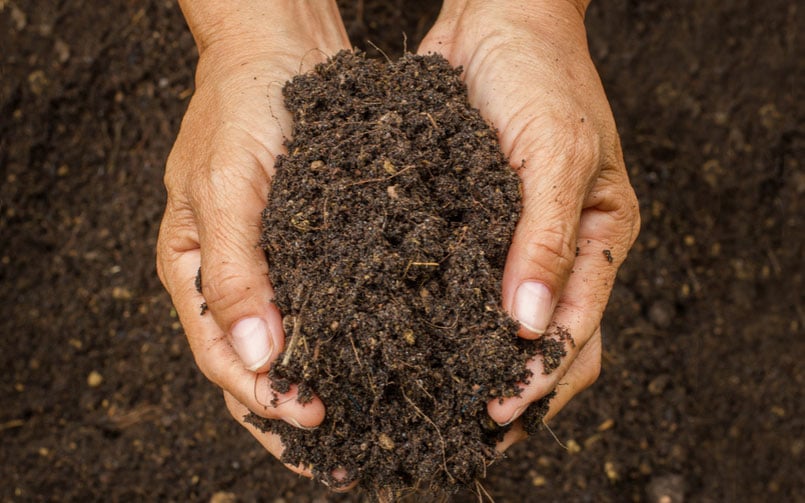You’ve got your big beautiful commercial planters from TerraCast ready to go—but what’s the best soil for potted plants? The higher quality soil you rely on, the healthier your plants are going to be. The thing is, the best soil for in-ground plants is drastically different from soil used for container planters. Gardening soil doesn’t provide the water, air or nutrients a plant requires to successfully grow in a container. Potting soils are used to overcome the obstacles plants face when confined to a big or small planter.
Three Things Good Potting Soil Must Offer
1. Commercial Planter Soil Must Drain
Potting soil must form a delicate balance to provide just enough drainage and moisture retention. Water needs to drain away from roots so that they can access air. In-ground plants have so much land beneath their roots, giving water ample space to trickle away and not soak the roots. Even planters with drainage holes tend to accumulate water at the bottom, that’s where self-watering planters come in handy.
A self-watering planter stores excess water in a separate chamber, preventing the roots from soaking in water and developing rot. You can add TerraCast “Drop in” self-watering basins to just about any planter, learn more https://www.terracastproducts.com/self-watering-planters/.
Quality potting soil helps prevent water from backing up. Soil with small pores leads to higher water retention, while soil with larger pores leads to better water flow. Larger pores are better suited to commercial planters because they help carry water to the roots and out through the bottom.
To increase soil pore size, add mineral aggregates to potting soils. Some commonly used mineral aggregates include perlite, calcined clay (aka kitty litter), and vermiculite. Both vermiculite and perlite are lightweight volcanic rocks that are naturally filled with air. Perlite is great because it does not lose its aerating ability if the mix is compressed, plus it does not decompose. Vermiculite remains a beneficial additive as well; it protects certain nutrients from seeping away and provides a boost of potassium and magnesium.
2. Potting Soil Must Retain Moisture
Quality potting mix is tasked with retaining a certain amount of moisture. Organic materials like coir or peat moss are used as a magnet of sorts for water, trapping moisture as it moves through the soil. These organic materials also work to retain nutrients that would otherwise drip away. It’s common for commercial fertilizers to contain bark or sawdust. Lime is another great additive used to balance the acidity of peat moss.
3. Potting Soil Must Provide Nutrients
Adding fertilizers can make up for lost nutrients. So too can adding organic materials like leaf mold and compost, offering plants a large variety of nutrients. Plants require nutrients like nitrogen, potassium and phosphorus to grow and thrive. Because potted plants rely on a smaller plot of soil they consume available nutrients at a faster rate. These nutrients must be replenished using fertilizers.
What About Garden Soil?
The garden soil your roses bloom in will not provide the same benefits to your potted plants, but what about using garden soil and then adding nutrients, compost, etc.?
Garden soil is rarely mixed in with commercial mixes because it is tricky to secure a consistent supply of quality product that does not contain toxins like herbicide residue. You could collect your own garden soil and then add the appropriate additives, but there are added risks in doing so. Soil taken from your property, or anywhere else, presents a higher risk for disease contamination, weeds, insects, etc.
Soil based medias weigh more, adding weight to planters. Still, there are benefits to natural garden soil, such as higher tolerance to inconsistencies and the ability to retain nutrients longer. Your best bet is to stick to a potting mix. Or, try mixing 25% soil with soilless media to enjoy the benefits of both.
The Type of Plant Matters
The species of plant you are growing should dictate the type of potting soil used. For instance, succulents, perennials and herbs thrive in soils that drain well and do not retain a lot of moisture. The best fillers are therefore bark, perlite, sand, or something thicker in texture. On the other hand, tropical and foliage plants prefer soil that retains a good deal of moisture. That means you’ll need a filler with extra peat to collect and retain more moisture. Do your research and know what your plants need to find both adequate and beneficial soil.
Can You Use the Same Soil Year After Year?
Soil can be used for longer than one year if plants remain in healthy condition and show no signs of disease, insect infestation, etc. No soil lasts forever, eventually the beneficial nutrients as well as drainage and aerate properties fade and soil must be replaced.
It can get pricy to fill up lots of planters with commercial soil. Try using a filler at the bottom of large planters, such as aluminum cans, plastic milk jugs, or non-biodegradable packing peanuts. Leave at least a couple inches of space at the top of the planter where there is no soil. This makes watering easier and more affordable.
Shop our unbeatable selection of commercial planters made in the USA: https://www.terracastproducts.com/our-shop/planters/

